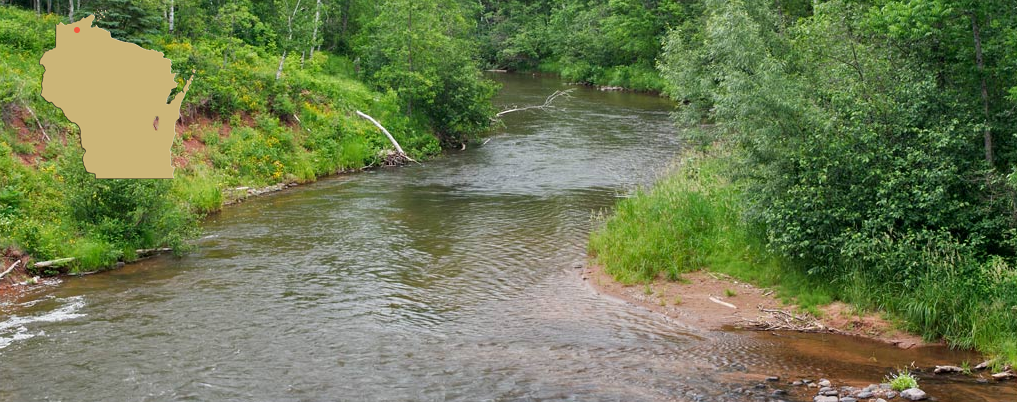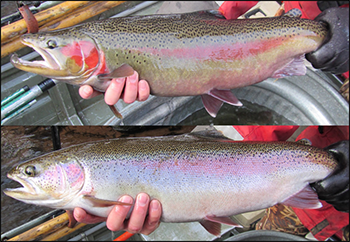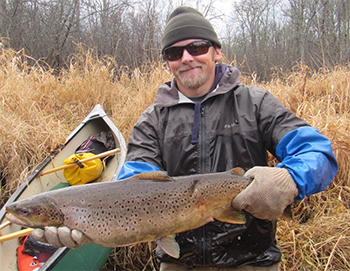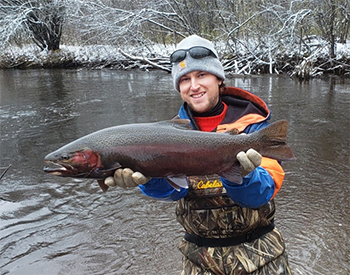Fishing the Brule River
Fishing Wisconsin
A gem of a fishing opportunity awaits
Recreational fishing is arguably the most popular outdoor activity on the Bois Brule River in the spring and fall of any given calendar year. From its mouth at Lake Superior 44 miles upstream to the Town of Solon Springs, the locally and regionally known river has attracted generations of Lake Superior migratory trout and salmon anglers. Steelhead (rainbow trout; Oncorhynchus mykiss) has been documented as a target species for decades. However, other species, such as brown trout (Salmo trutta), coho salmon (O. kisutch) and Chinook salmon (O. tshawytscha), have broadened angling opportunities and helped create a unique sport fishery. Pink salmon (O. gorbuscha) and Atlantic salmon (S. salar) have occasionally been observed over the years. Although the migratory ("coaster" or "coastal") form of brook trout (Salvelinus fontinalis) has been observed in the lower river, the in-stream "resident" form of brook trout is among the most popular target species throughout the upper river reaches and is the only salmonid native to the river.
A Catch Calendar of Brule River Fishing
When, Where and How to Catch 'Em
The steelhead run begins in late March in the spring and extends through May. Fish that "overwinter" or remain in the river from the previous fall run are typically the first fish caught. Bright, spring-run fish start appearing in April and continue through early May. Water temperatures dictate peak movement. Most fish are taken on yarn flies, spawn beads, large caddisfly imitations and various types of conventional hardware (i.e., spoons and spinners). Deep runs and pools are the favorite holding areas for the fish.
Lake-run brown trout begin appearing in the river in early July and extend through late October. The peak is from mid-July to mid-September. Favorite baits include spoons, spinners, flatfish and live bait such as nightcrawlers. Lake-run brown trout is not an easy fish to catch, but with persistence and by fishing the slower, deep holes during low-light periods, the odds of landing one increase greatly.
A smaller run of Chinook salmon ascends the river from early July through mid-October, peaking between mid-August and late September. Most Chinook salmon are taken soon after they enter the stream. At this time, they are still silver and are quite a battle for even the most experienced angler. They prefer flashing or colorful lures like spinners, spoons or Rapalas and tend to hold in slower, deeper water.
Coho salmon are found moving up the Brule from late August to late November. Depending on water conditions (i.e., water flow, temperature and clarity), peak runs can be found in early to late September. Coho salmon can be caught on a variety of bait selections, including spoons, spawn, beads and several various fly lures. They can be found in slower water areas.
Fall-run steelhead begins moving up the Brule in mid-August and continues through late November. The most extensive runs usually occur sometime between mid-September and late October. Water conditions will affect the exact timing of the run so that the peak will vary from year to year. One can expect to find the fish associated with the moderate velocity areas but usually behind or near some current break (i.e., rocks, logs, stream banks). They will tend to hold in the deeper holes as the water temperature drops later in the season. Various baits, including yarn flies, spawn, beads, flatfish and all types of spoons and spinners, are appealing to fall-run steelheads.
Fishing Access
The river north of U.S. Hwy. 2 has many well-marked day-use access points to Lake Superior. They are located throughout the lower river and provide an excellent opportunity to fish different river sections as they change character. Overnight camping is limited to designated campgrounds.
The section of the river south of Co. Hwy. B is noted for its resident brown and brook trout fishery. Some of the best fishing occurs in the stretch between Co. Hwy. B and Co. Hwy. S. (special regulations stretch). This part of the river is slow and wide and is excellent for fly fishing. The larger insect hatches occur in this area from May to the end of June. This area gets heavy canoe traffic during the summer months, especially during weekends.
The land adjacent to the river between Stones Bridge on Co. Hwy. S to just below Co. Hwy. B is mostly privately owned, so access is limited.
There are two state forest campgrounds located on the Brule River. Copper Range is located approximately four miles north of the town of Brule. The other (Bois Brule) is located near the Ranger Station, about one mile southwest of Brule. There is no electricity provided at either of these sites. If desired, a private campground (Brule River Campground) is located in Brule on U.S. Hwy. 2.
Steelhead Updates - Fall
- 2023 Brule River fall fishway update [PDF]
- 2022 Brule River fall fishway update [PDF]
- 2021 Brule River fall fishway update [PDF]
- 2020 Brule River fall fishway update [PDF]
- 2019 Brule River fall fishway update [PDF]
Steelhead Updates - Spring
- 2023 Brule River spring steelhead run update [PDF]
- 2022 Brule River spring steelhead run update [PDF]
- 2021 Brule River spring steelhead run update [PDF]
- 2020 Brule River spring steelhead run update [PDF]
- 2019 Brule River spring steelhead run update [PDF]
Brule River Regulations
Fishing on the Bois Brule River is some of the best in the region, mainly due to the river's different segments that are managed for resident and lake-run trout and salmon. Each segment offers its own unique fishing experience. Fishing for trout and salmon on the river and its tributaries requires an inland trout stamp. Brule River State Forest angler parking lots are for day use only; overnight camping is limited to designated campgrounds. Find a copy of the entire Guide to Wisconsin Trout Fishing Regulations, 2024-2025.
Downstream from U.S. Hwy. 2 to Lake Superior
The season begins on the last Saturday in March and continues through Nov. 15. Fishing is prohibited from one-half hour after sunset to one-half hour before sunrise. Special Note: fishing may not begin before 5 a.m. on the first Saturday in May.
The daily bag limit is five (5) trout or salmon in total.
Rainbow - minimum length 26" (only one may be kept)
Brown - minimum length 10" (only two may be larger than 15")
Brook - minimum length 8"
Salmon - minimum length 12"
U.S. Hwy. 2 Upstream to County Hwy. B
This section of the Brule River and all of its tributaries are open to fishing on the first Saturday in May (at 5 a.m.) and continues through Sept. 30.
The daily bag limit is five (5) trout or salmon in total.
Rainbow - minimum length 26" (only one may be kept)
Brown - minimum length 10" (only two may be larger than 15")
Brook - minimum length 8"
Salmon - minimum length 12"
County Hwy. B Upstream to County Hwy. S
This section of the Brule River opens to fishing on the first Saturday in May (at 5 a.m.) and continues through Sept. 30. Also, this section of the river has a special regulation with more restrictive bag limits, and only artificial lures may be used.
The daily bag limit is three (3) trout or salmon in total.
Rainbow - minimum length 26" (only one may be kept)
Brown - minimum length 15" (only two may be kept)
Brook - minimum length 10"
Salmon- minimum length 12"
Upstream from County Hwy. S
This section of the Brule River and all its tributaries are open to fishing on the first Saturday in May (at 5 a.m.) and continues through Sept. 30.
The daily bag limit is five (5) trout or salmon in total.
Rainbow - minimum length 26" (only one may be kept)
Brown - minimum length 10" (only two may be larger than 15")
Brook - minimum length 8"
Salmon - minimum length 12"





